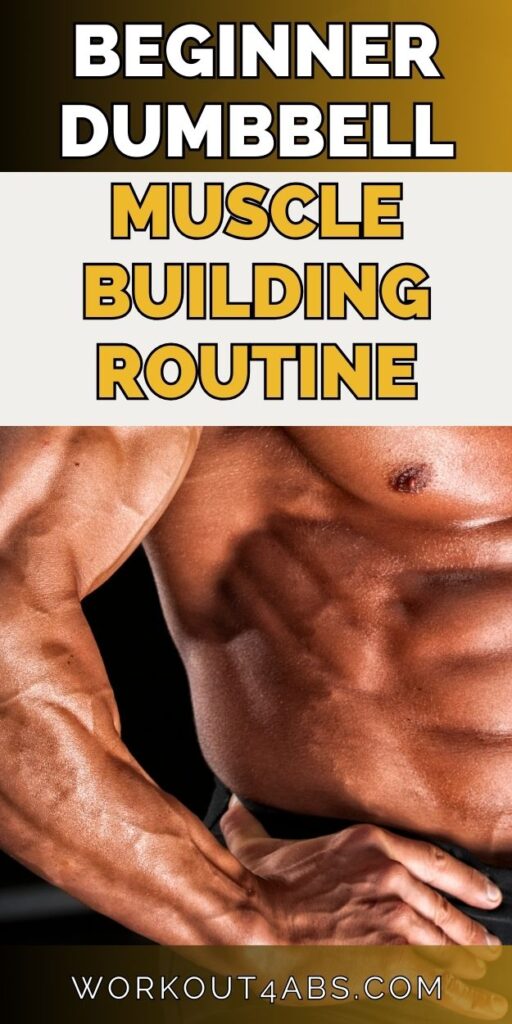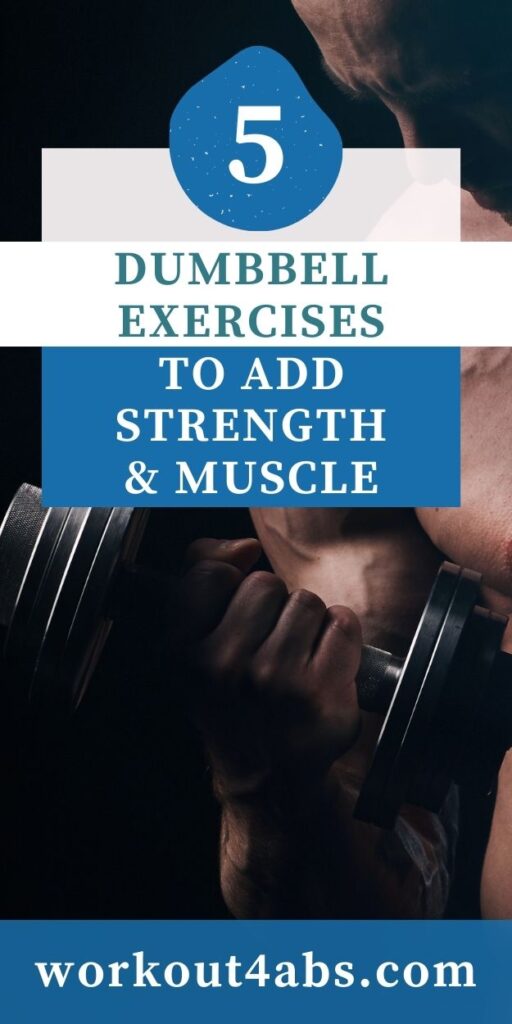Discover a dumbbell workout for beginners that helps you build muscle mass. In the realm of muscle-building, simplicity often reigns supreme. This article unveils the quintessential 5 dumbbell exercises that stand as pillars in your journey to gaining muscle mass. From chest to legs and all points in between, discover the essential moves that maximize your gains and transform your physique.
The ONLY 5 Dumbbell Exercises You Need for Muscle Mass
If you enjoyed these tips, please save this pin to your Pinterest Board.

Dumbbell Goblet Squat
The dumbbell goblet squat is a compound exercise that targets your quadriceps, glutes, hamstrings, and core muscles. It’s an excellent lower body and core strength builder. Here’s how to perform a dumbbell goblet squat:
Equipment Needed:
- One dumbbell (or kettlebell)
- Flat and stable surface to stand on
Step-by-Step Instructions:
- Set Up:
- Begin by selecting an appropriate dumbbell weight. If you’re new to this exercise, start with a lighter weight to ensure proper form.
- Stand with your feet shoulder-width apart, toes slightly turned out.
- Hold the Dumbbell:
- Hold the dumbbell vertically with both hands, cupping the top part of the dumbbell close to your chest. Your palms should be under the top weight plate, and your elbows should be pointing down.
- Positioning:
- Keep your chest up, shoulders down and back, and your back straight throughout the exercise.
- Engage your core muscles to maintain stability.
- Squatting:
- Initiate the squat by pushing your hips back and bending your knees.
- Lower your body down while keeping your chest up and maintaining a neutral spine. Your elbows should be between your knees.
- Continue descending until your thighs are at least parallel to the ground or ideally lower, but without letting your lower back round excessively.
- Pause and Exhale:
- At the bottom of the squat, pause for a moment, ensuring you have good balance and control.
- Exhale as you push through your heels to stand back up to the starting position.
- Complete the Repetitions:
- Perform the desired number of repetitions, typically 8-12 reps for muscle-building purposes.
- Finish:
- After your last repetition, carefully set the dumbbell down.
- Take a moment to stretch or shake out your legs if needed.
Tips:
- Ensure your knees are tracking in line with your toes as you squat to avoid unnecessary stress on the knee joints.
- Keep your heels on the ground throughout the movement.
- Maintain a steady and controlled pace, both during the descent and ascent.
- If you’re new to goblet squats, practice with lighter weights to perfect your form before gradually increasing the load.
The dumbbell goblet squat is a versatile exercise that can be incorporated into full-body workouts, lower body workouts, or circuit training routines. It not only builds strength but also helps improve mobility and stability in your lower body and core.
Dumbbell Deadlift
The dumbbell deadlift is a compound exercise that primarily targets the muscles in your lower back, glutes, hamstrings, and lower body. It also engages your core and grip strength. Here’s how to perform a dumbbell deadlift:
Equipment Needed:
- Two dumbbells of appropriate weight
Step-by-Step Instructions:
- Set Up:
- Begin by selecting two dumbbells of the desired weight. Place them on the ground in front of you.
- Stand with your feet hip-width apart, with your toes pointing forward.
- Position the dumbbells about shoulder-width apart in line with the middle of your feet.
- Grip the Dumbbells:
- Bend at your hips and knees to lower yourself to the dumbbells.
- Bend your knees just enough to comfortably reach the dumbbells while keeping your back straight.
- Grip the dumbbells with a neutral grip (palms facing your body), ensuring your hands are centered and balanced.
- Setup Position:
- Your arms should hang straight down from your shoulders, and your shoulders should be pulled back and down, keeping your chest open.
- Your back should remain flat, and your spine should maintain its natural curve throughout the exercise. Avoid rounding your lower back.
- Engage your core muscles to stabilize your spine.
- Lift the Dumbbells:
- Push through your heels and lift the dumbbells by extending your hips and knees simultaneously. Keep the dumbbells close to your body as you stand up.
- As you lift, maintain a strong and upright posture, ensuring your shoulders are back and your chest is up.
- Full Extension:
- At the top of the movement, stand fully upright with your hips and knees fully extended. Squeeze your glutes at the top.
- Hold the position for a brief moment to ensure full extension and control.
- Lower the Dumbbells:
- To lower the dumbbells back to the ground, hinge at your hips and push your hips back as you bend your knees slightly.
- Keep the dumbbells close to your body, and lower them under control until they touch the ground.
- Repeat:
- Perform the desired number of repetitions, typically 8-12 reps for muscle-building purposes.
Tips:
- Maintain a strong, neutral spine throughout the exercise. Avoid rounding or arching your lower back.
- Keep the dumbbells close to your body throughout the movement to minimize stress on your lower back.
- Breathe in as you lower the dumbbells and exhale as you lift them. Use proper breathing to stabilize your core.
- Start with a weight that allows you to perform the exercise with good form. As you progress, gradually increase the weight.
The dumbbell deadlift is an effective full-body exercise that can be incorporated into strength training routines or used as part of a total body workout. It helps develop strength in your posterior chain (lower back, glutes, hamstrings), promotes overall functional strength, and is an excellent alternative to the barbell deadlift when barbells are not available.
Dumbbell Row
The dumbbell row is a compound exercise that targets the muscles of your upper back, particularly the latissimus dorsi (lats), rhomboids, and trapezius. It’s an effective exercise for building upper body strength and improving posture. Here’s how to perform a dumbbell row:
Equipment Needed:
- One dumbbell
- Bench or sturdy surface
Step-by-Step Instructions:
- Set Up:
- Place a dumbbell on the floor next to a bench or sturdy surface.
- Stand facing the bench, with your feet shoulder-width apart. The bench should be parallel to your body.
- Positioning:
- Bend your knees slightly and hinge at your hips to lean forward, keeping your back straight. Your torso should be at roughly a 45-degree angle to the ground.
- Extend your right arm to grasp the dumbbell on the floor with an overhand grip (palm facing your body).
- Your left hand can be placed on the bench for support and balance. Keep your back flat and your head in line with your spine.
- Initiate the Row:
- While maintaining a stable and neutral spine, exhale and pull the dumbbell towards your hip by bending your elbow. Keep your elbow close to your body as you lift the weight.
- Squeeze your shoulder blades together at the top of the movement to engage your upper back muscles.
- Your upper arm should be close to your torso, and your forearm should be the only part of your arm moving during the row.
- Full Contraction:
- At the top of the row, your elbow should be at or slightly behind your torso, and the dumbbell should be close to your hip.
- Hold this position for a brief pause to feel the contraction in your upper back muscles.
- Lower the Dumbbell:
- Inhale and slowly lower the dumbbell back to the starting position, fully extending your arm.
- Keep your back straight and your core engaged throughout the movement.
- Repeat:
- Perform the desired number of repetitions on one side before switching to the other.
- A typical range for muscle-building is 8-12 reps per set.
Tips:
- Start with a light dumbbell to practice proper form before gradually increasing the weight.
- Keep your core engaged to stabilize your spine and maintain good posture.
- Avoid using momentum to lift the dumbbell; focus on controlled movements.
- Keep your neck in a neutral position by looking at the ground a few feet in front of you.
- Maintain a strong, stable stance with your feet shoulder-width apart.
- Ensure your breathing is controlled: exhale during the lifting phase and inhale during the lowering phase.
The dumbbell row is an effective exercise for targeting the muscles of the upper back and building strength in the lats and rhomboids. It’s a valuable addition to any upper body strength training routine and can help improve posture and shoulder stability when performed correctly.
If you enjoyed these tips, please save this pin to your Pinterest Board.

Dumbbell Shoulder Press
The dumbbell shoulder press, also known as the dumbbell overhead press, is a compound exercise that targets the deltoid muscles of the shoulders and also engages the triceps and upper chest. It’s an excellent exercise for building shoulder strength and developing well-rounded shoulder muscles. Here’s how to perform a dumbbell shoulder press:
Equipment Needed:
- Two dumbbells of appropriate weight
- Exercise bench (optional)
Step-by-Step Instructions:
- Set Up:
- Begin by selecting two dumbbells of the desired weight. Sit on an exercise bench with back support if available, or you can perform this exercise while standing.
- Hold one dumbbell in each hand at shoulder height with your palms facing forward and your elbows bent at 90 degrees. Your upper arms should be parallel to the floor, and your forearms should be vertical.
- Seated Position (Optional):
- If you’re using a bench, sit with your back firmly against the backrest, and your feet flat on the ground, about hip-width apart. Keep your core engaged to maintain stability.
- If you prefer to stand, keep your feet shoulder-width apart for balance.
- Pressing the Dumbbells:
- Exhale and press the dumbbells upward by extending your elbows. Push the weights directly overhead until your arms are fully extended but not locked out at the top.
- Keep your head in a neutral position, and avoid leaning forward or backward. Maintain a straight and strong posture.
- Full Extension:
- At the top of the movement, your arms should be fully extended, and the dumbbells should be directly above your head. Your biceps should be near your ears, and your wrists should be in line with your elbows.
- Lower the Dumbbells:
- Inhale and slowly lower the dumbbells back to the starting position, bringing them down to shoulder height. Keep your core engaged and maintain control as you lower the weights.
- Repeat:
- Perform the desired number of repetitions, typically 8-12 reps for muscle-building purposes.
Tips:
- Use a weight that challenges you but allows you to maintain proper form throughout the set.
- Avoid excessive arching of the lower back during the movement; keep your core engaged and maintain a neutral spine.
- Keep your wrists straight and aligned with your forearms throughout the exercise to reduce the risk of wrist strain.
- Maintain a controlled tempo, especially during the lowering phase to prevent any jerky movements.
- If you experience discomfort or pain in your lower back or shoulders, reduce the weight or seek guidance from a fitness professional to ensure proper form.
The dumbbell shoulder press is a fundamental exercise for developing shoulder strength and stability. It can be incorporated into upper body strength training routines and is essential for building well-rounded shoulder muscles and improving overhead strength.
Dumbbell Chest Press
The dumbbell chest press is a compound exercise that targets the pectoral (chest) muscles, as well as the shoulders and triceps. It’s a fundamental movement for building upper body strength and muscle. Here’s how to perform a dumbbell chest press:
Equipment Needed:
- A pair of dumbbells
- Exercise bench (optional)
Step-by-Step Instructions:
- Set Up:
- Begin by selecting a pair of dumbbells that match your desired weight and fitness level.
- If you have an exercise bench, adjust it to a flat or slightly inclined position. If you don’t have a bench, you can perform this exercise on the floor.
- Lying Down:
- Sit on the edge of the bench or position yourself on the floor with your back flat against it. If you’re using a bench, make sure your head, upper back, and buttocks are firmly supported.
- Hold a dumbbell in each hand with your palms facing forward, and your arms extended straight up above your chest. Your hands should be positioned slightly wider than shoulder-width apart.
- Lowering the Dumbbells:
- Inhale and slowly lower the dumbbells down to the sides of your chest. Keep your elbows at a 90-degree angle or slightly wider as you lower the weights.
- Maintain control as you lower the dumbbells to prevent them from dropping too quickly. Your upper arms should be parallel to the floor or slightly below.
- Pressing the Dumbbells:
- Exhale and push the dumbbells back up to the starting position by extending your arms fully. Keep your wrists straight and maintain control throughout the movement.
- Full Extension:
- At the top of the movement, your arms should be fully extended, and the dumbbells should be above your chest.
- Avoid locking out your elbows at the top; keep a slight bend in your elbows to prevent strain.
- Repeat:
- Perform the desired number of repetitions, typically 8-12 reps for muscle-building purposes.
Tips:
- Use a weight that challenges you but allows you to maintain proper form. If you’re a beginner, start with lighter weights to practice the movement.
- Keep your feet flat on the floor or firmly planted on the bench for stability.
- Maintain a natural arch in your lower back, and keep your core engaged throughout the exercise to protect your spine.
- Focus on a controlled tempo, especially during the lowering phase, to work the chest muscles effectively.
- Keep your head and neck in a neutral position, looking straight up or slightly forward to prevent straining your neck.
The dumbbell chest press is a versatile exercise that can be performed on a flat bench, incline bench, or decline bench to target different areas of the chest. It’s an essential exercise for building chest strength and muscle mass and is commonly included in upper body strength training routines.
If you enjoyed these tips, please save this pin to your Pinterest Board.

Home › Workout for Athletes ›Dumbbell Workout for Beginners